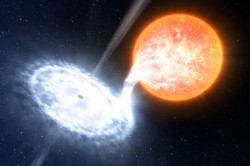Since black holes are the most powerful gravitational spots in the entire Universe, can they distort light so much that it actually goes into orbit? And what would it look like if you could survive and follow light in this trip around a black hole?
I had this great question in from a viewer. Is it possible for light to orbit a black hole?
Consider this thought experiment, first explained by Newton. Imagine you had cannon that could shoot a cannonball far away. The ball would fly downrange and then crash into the dirt. If you shot the cannonball harder it would fly further before slamming into the ground. And if you could shoot the cannonball hard enough and ignore air resistance – it would travel all the way around the Earth. The cannonball would be in orbit. It’s falling towards the Earth, but the curvature of the Earth means that it’s constantly falling just over the horizon.
This works not only with cannonballs, astronauts and satellites, but with light too. This was one of the big discoveries that Einstein made about the nature of gravity. Gravity isn’t an attractive force between masses, it’s actually a distortion of spacetime. When light falls into the gravity well of a massive object, it bends to follow the curvature of spacetime.
Distant galaxies, the Sun, and even our own Earth will cause light to be deflected from its path by their distortion of spacetime. But it’s the incredible gravity of a black hole that can tie spacetime in knots. And yes, there is a region around a black hole where even photons are forced to travel in an orbit. In fact, this region is known as the “photon sphere”.
From far enough away, black holes act like any massive object. If you replaced the Sun with a black hole of the same mass, our Earth would continue to orbit in exactly the same way. But as you get closer and closer to the black hole, the orbiting object needs to go faster and faster as it whips around the massive object. The photon sphere is the final stable orbit you can have around a black hole. And only light, moving at, well, light speed, can actually exist at this altitude.

Imagine you could exist right at the photon sphere of a black hole. Which you can’t, so don’t try. You could point your flashlight in one direction, and see the light behind you, after it had fully orbited the black hole. You would also be bathed in the radiation of all the photons captured in this region. The visible light might be pretty, but the x-ray and gamma radiation would cook you like an oven.
Below the photon sphere you would see only darkness. Down there is the event horizon, light’s point of no return. And up above you’d see the Universe distorted by the massive gravity of the black hole. You’d see the entire sky in your view, even stars that would be normally obscured by the black hole, as they wrap around its gravity. It would be an awesome and deadly place to be, but it’d sure beat falling down below the event horizon.
If you could get down into the photon sphere, what kind of experiments would you want to do? Tell us in the comments below.


Actually, if there were a way to survive in there, I would want to dive on into the singularity at the center, just to see Where and When it would lead. Maybe through a wormhole and back to the big bang, or another universe, another galaxy, who knows? Of course, the worst part would be not coming back to tell your tale.
I did this thought experiment myself when I was in grad school (20 years ago). I came up with different conclusions though.
First, there wouldn’t be a stable photon sphere. All of the photons that happened to hit the “sweet spot” such that they would orbit initially would find themselves in a decaying orbit as soon as the black hole gained any more mass. They would begin spiraling in toward the black hole.
Second, I don’t believe it would be dark below the threshold of the photon sphere. It would be filled with photons that either just came on the too close side of the photon sphere or photons that were in the photon sphere but whose orbit was changed by an increase of mass in the black hole. These photons would be slowly spiraling in to the center of mass or colliding with matter that is falling into the black hole.